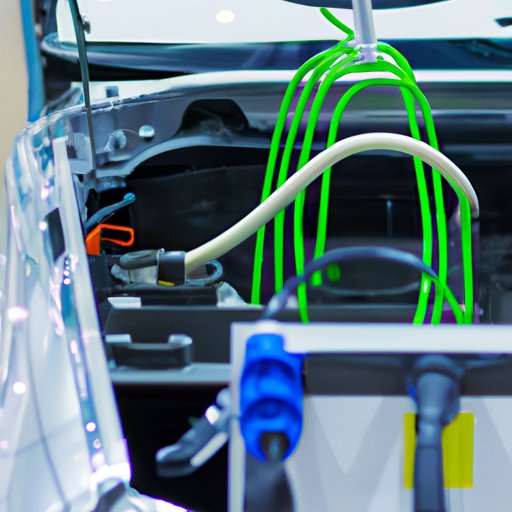Introduction
An electric car is a vehicle powered by electricity from batteries or fuel cells. Electric cars have become increasingly popular in recent years due to their environmental advantages and cost savings. In this article, we will explore how an electric car works and the benefits it can provide.
Step-by-Step Guide to How an Electric Car Works
The powertrain of an electric car consists of several components, including the motor, controller, and battery pack. The motor converts electricity into mechanical energy, while the controller regulates the amount of power supplied to the motor. The battery pack stores the electrical energy required to power the car.
The mechanics behind an electric car are quite simple. When the driver presses the accelerator pedal, the controller sends an electrical signal to the motor, which causes it to rotate. This rotation turns the axle, which then propels the car forward. The speed of the car is determined by the amount of electricity supplied to the motor, which is regulated by the controller.
Electric vehicles use a variety of technologies to power them, including hybrid electric, plug-in hybrid electric, and all-electric. Hybrid electric cars combine gasoline and electric power, while plug-in hybrids can be plugged into an outlet to recharge the battery. All-electric cars are powered solely by electricity and do not require any gasoline.
Benefits of Electric Cars and How They Work
Electric cars offer several benefits over traditional gasoline-powered vehicles. For starters, they produce fewer emissions, making them better for the environment. Additionally, they are more efficient, resulting in lower fuel costs. Finally, electric cars are generally easier to maintain than gasoline-powered cars, as they require less frequent servicing and repairs.
What Is an Electric Car Battery and How Does It Work?
The battery is one of the most important components of an electric car. It stores the electrical energy required to power the car and consists of several different parts. The battery pack contains individual cells that are connected together in series and parallel configurations. These cells store the electrical energy and supply it to the motor when needed.
The inner workings of an electric car battery are quite complex. Each cell contains a positive and negative electrode, as well as a liquid electrolyte. When the battery is charged, the electrons flow from the negative electrode to the positive electrode, creating a flow of electricity. When the battery is discharged, the electrons move back to the negative electrode, releasing the stored energy.
Charging an electric car battery is relatively straightforward. The battery is connected to an external power source, such as a wall socket or charging station. The power source supplies electricity to the battery, which charges the cells. Depending on the type of battery, charging times can range from a few hours to a few days.
Conclusion
Electric cars offer a number of advantages over traditional gasoline-powered vehicles. They produce fewer emissions, cost less to operate, and require less maintenance. An electric car’s powertrain consists of several components, including the motor, controller, and battery pack. The battery stores the electrical energy required to power the car, and is composed of several different parts. Charging an electric car battery is relatively easy and can be done using an external power source.
Overall, electric cars are becoming increasingly popular due to their environmental and economic benefits. Understanding how electric cars work is essential for taking full advantage of these benefits.
(Note: Is this article not meeting your expectations? Do you have knowledge or insights to share? Unlock new opportunities and expand your reach by joining our authors team. Click Registration to join us and share your expertise with our readers.)
